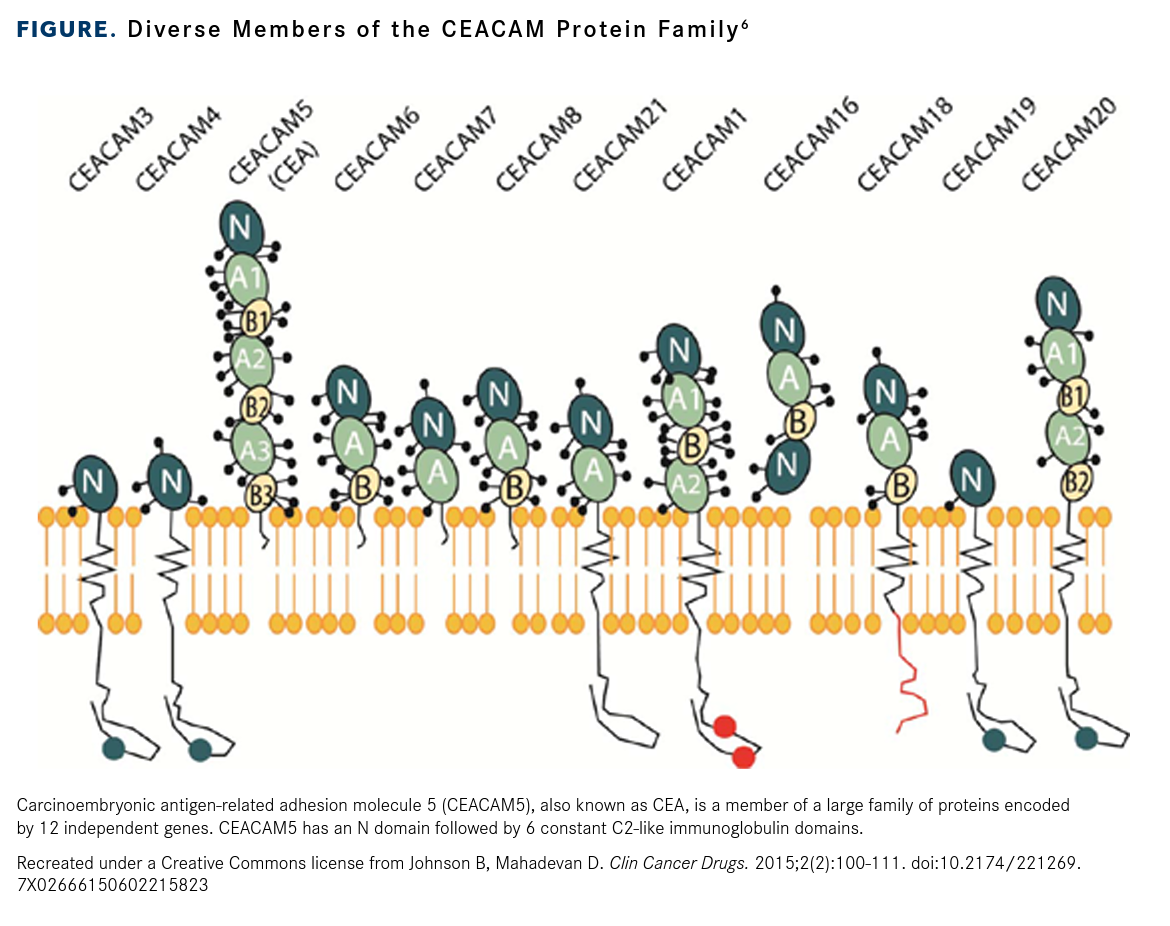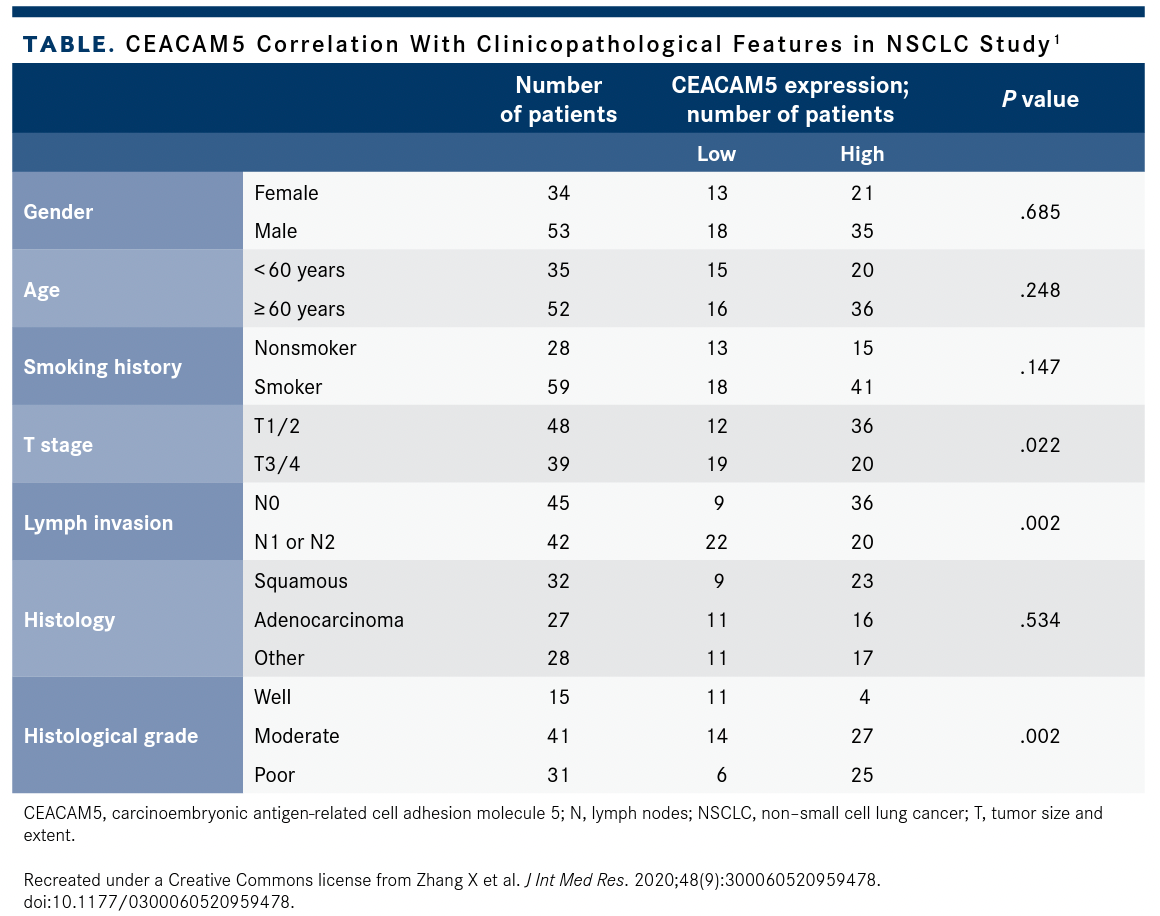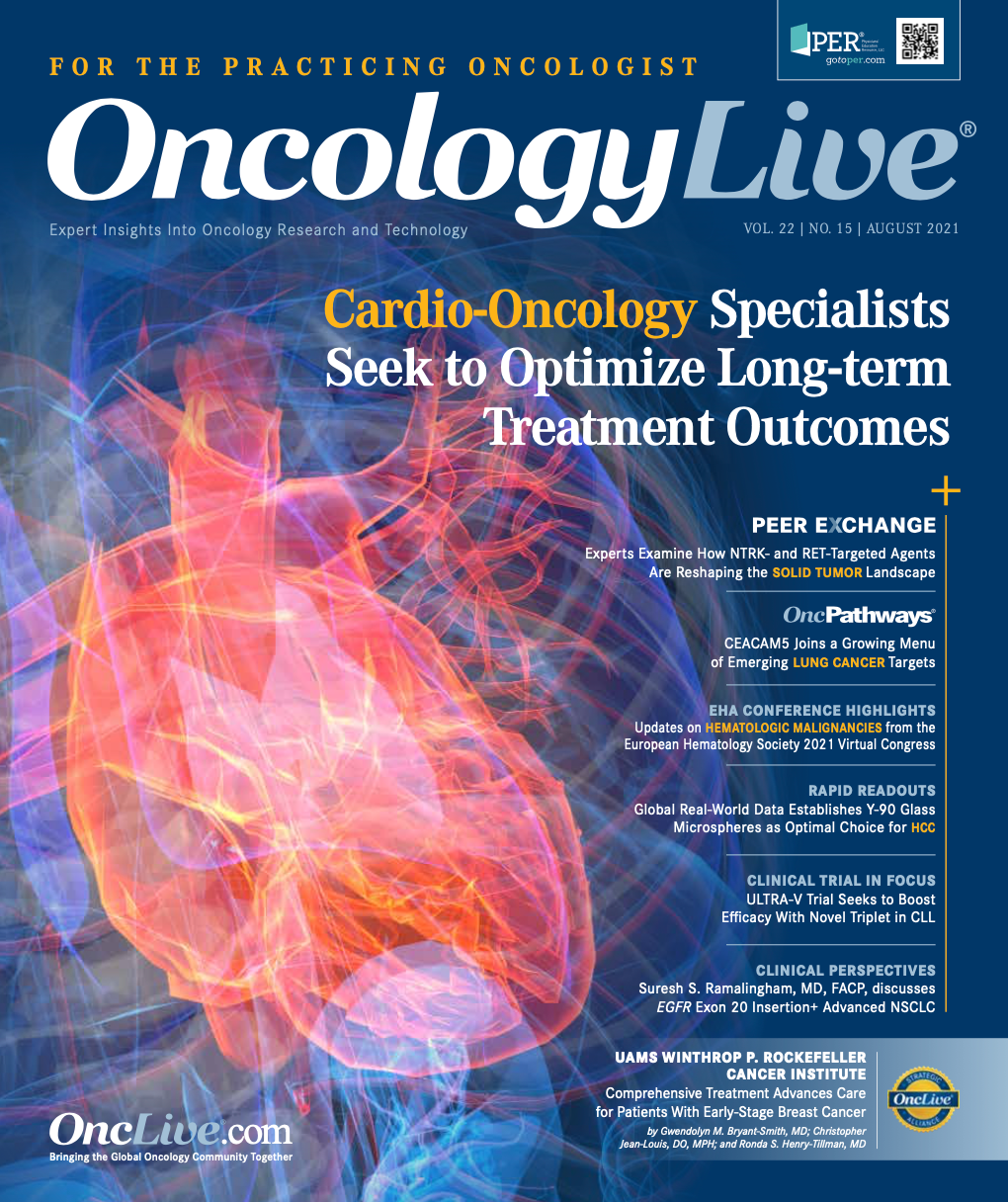CEACAM5 Joins a Growing Menu of Emerging Lung Cancer Targets
After nearly two decades of successfully developing therapies directed at molecular aberrations in non–small cell lung cancer, investigators are exploring a new generation of novel targets, including some not specifically associated with driver mutations.
Paul A. Bunn Jr, MD

After nearly 2 decades of of successfully developing therapies directed at molecular aberrations in non–small cell lung cancer (NSCLC), investigators are exploring a new generation of novel targets, including some not specifically associated with driver mutations. One of these emerging targets is carcinoembryonic antigen–related cell adhesion molecule 5 (CEACAM5), a glycoprotein implicated in a variety of oncogenic activities.1
CEACAM5 is overexpressed on the surface of multiple solid tumors, including in about 20% of patients with NSCLC adenocarcinoma, but is not found in normal lung tissue.2,3 This makes CEACAM5 a potentially attractive therapeutic target, although efforts to design lung cancer drugs aimed at the protein have been limited.
Currently, tusamitamab ravtansine (SAR408701), an antibody-drug conjugate (ADC), is the most advanced novel agent in clinical testing targeting CEACAM5 specifically in patients with NSCLC, according to a search of ClinicalTrials. gov. Tusamitamab ravtansine has entered phase 3 development in the CARMEN-LC03 trial (NCT04154956), in which investigators are comparing the drug with docetaxel in patients with metastatic nonsquamous NSCLC (NSQ-NSCLC) whose disease has progressed after prior therapy and whose tumors express CEACAM5 at 2+ intensity on at least 50% of the tumor cell population via immunohistochemistry (IHC) testing.
The exploration of new targets such as CEACAM5 would represent another stage in the development of therapies for subsets of patients in NSCLC. Experts in lung cancer and precision medicine discussed the most recent data for some of the novel agents directed at these emerging targets during Molecular Targets on the Horizon in Non–Small Cell Lung Cancer OncLive® Scientific Interchange & Workshop, a panel discussion held on May 25, 2021
Since the FDA approved the first EGFRtargeted tyrosine kinase inhibitor, gefitinib (Iressa), in 2003,4 the list of noteworthy genomic alterations in NSCLC has grown to 14, according to the European Society for Medical Oncology Scale for Clinical Actionability of Molecular Targets.5 The FDA has now approved drugs for 9 of these targets, noted program moderator Paul A. Bunn Jr, MD, a 2014 Giants of Cancer Care® award winner in the lung cancer category. Moving forward, novel targets that may be relevant based on protein subtyping include CEACAM5, HER2, HER3, TROP-2, MET, and SHP2.
“Many of these [newer] targets are not driver alterations, and thus they’re often targeted not by tyrosine kinase inhibitors but by antibodies or antibody-drug [conjugates] that identify the target and attack the target, which is somewhat different [from] the tyrosine kinase inhibitors that have been developed for what we canister as targeted or molecular therapy at the moment,” said Bunn, the James Dudley Chair in Cancer Research and a distinguished professor of medicine–medical oncology at the University of Colorado School of Medicine in Aurora.
With ADCs, the question of what is driving the malignancy may be different from what it is with the identification of an oncogenic driver, panel member Tejas Patil, MD, said. “It’s less important, or maybe we can have a discussion about the relative importance of this—whether the protein expression isn’t [in and] of itself a driver, but rather whether it’s a target that’s appropriate for an antibody-drug conjugate,” said Patil, an assistant professor of medicine–medical oncology at the University of Colorado School of Medicine. “What’s really important is trying to define some kind of protein expression level where we feel that it adequately enriches for the delivery of the antibody-drug conjugate.”
Tejas Patil, MD

As therapeutic targets become more numerous and diverse, the language used in the field also should change, observed Justin F. Gainor, MD, director of the Center for Thoracic Cancers and of targeted immunotherapy at Massachusetts General Hospital in Boston, Massachusetts. “We have the bad habit of saying ‘ALK positive,’ but when we’re mixing in protein targets as well as mutations and fusions, I think it forces us to actually be much more specific. Especially things like MET. People say ‘MET positive,’ but are you talking about MET amplification, MET exon 14 skipping, MET overexpression by IHC? I think it just really will require us to be much more specific in our discussions.”
Justin F. Gainor, MD

History as a Biomarker
Although recent findings have made CEACAM5 a therapeutic target for NSCLC, the protein has a long history as a tumor biomarker. In 1965, investigators discovered carcinoembryonic antigen (CEA) as a marker for colorectal cancer (CRC), and it has since become widely used for the detection and monitoring of that malignancy.6 The Centers for Medicare & Medicaid Services also accepts serum CEA assays for monitoring responses to therapy in a range of cancers, including stomach, esophageal, pancreatic, lung, and breast cancers.7
Initially, CEA was thought to be restricted to fetal expression and malignancy but was later identified in normal adult tissue of the appendix, bone marrow, colon, gallbladder, stomach, and urinary bladder.3,6
The development of DNA sequencing and monoclonal antibody technologies has enabled a more intricate understanding of CEA as CEACAMs, a family of 12 glycosylated proteins that belong to the immunoglobulin supergene family.3,6 Of these, only CEACAM5, which also is referred to as CEA, has been accepted as a marker for cancer and recurrence,6although CEACAM1 and CEACAM6 also have potential as markers for other malignancies.6.8
The continued exploration of CEACAMs has revealed that the family members share certain similarities in structure and function but also have differences. Although all members are anchored to the cell membrane, CEACAMs 5,6,7, and 8 are attached to the cell surface through glycophosphatidylinositol, whereas 6 others attach through transmembrane domains. Each member has an N domain and 0 to 6 constant C2-like immunoglobulin domains, with CEACAM5 having the most C2-like domains (FIGURE).6
FIGURE: Diverse Members of the CEACAM Protein Family6

Investigators have associated CEACAMs with complex biological functions during cancer progression, metastasis, angiogenesis, and inflammation.3 More than 20 years ago, results of experiments involving cell lines showed that CEACAM5 overexpression inhibits anoikis, a process important to the apoptosis of cancer cells.1,9 Moreover, results of prior studies have shown that CEACAM5 is expressed in about 90% of gastrointestinal, colorectal, and pancreatic cancers and in 50% of breast cancer samples.1
In 2020, Zhang et al published findings from analyses of CEACAM5 expression and activity in NSCLC tissue, cell lines, and mice using quantitative reverse transcription polymerase chain reaction and IHC testing. They found that CEACAM5 stimulated cancer progression in NSCLC through cell proliferation and migration via the p38-SMAD2/3 signaling pathway.1
Further, investigators used IHC to characterize CEACAM5 expression in tumor issue from 87 patients treated at Linyi Central Hospital in China and correlated the samples with clinicopathological features (TABLE1). They found that CEACAM5 expression via IHC testing was significantly associated with tumor stage (P = .022), lymph invasion (P = .002), and histological grade (P = .002). Of note, CEACAM5 expression was not significantly associated with smoking history (P = .147).1
TABLE. CEACAM5 Correlation With Clinicopathological Features in NSCLC Study1

The findings also demonstrated differences in the extent of cells that positively stained for CEACAM5 on IHC testing, graded as 0 for no positively stained cells, 1 for 1% to 30%, 2 for 31% to 80%, and 3 for 81% or more. Staining indices of less than 3 were rated as low expression, whereas those that were 3 or higher were labeled high expression.1
In another analysis, CEACAM5 was detected in 38% of lung adenocarcinoma samples (N = 58) and 20% of squamous cell samples (N = 143), but expression differed markedly from weak to very strong expression.10 “Like any protein, the cell surface expression, if you use an IHC test, can be weak, moderate, or strong,” Bunn noted during the OncLive® program. “Among the expressors, weak is not too common and strong is not too common. Most of them have moderate protein expression.” Bunn also observed that CEACAM5 is expressed in both adenocarcinoma and squamous tissue. “If you’re going to test, you have to test both histologies, which is arguably a good thing,” he said.
CEACAM5 as a Therapeutic Target
In terms of clinical development, investigators have explored CEACAM5 as a therapeutic target in several novel formats, including ADCs, bispecific antibodies, radioimmunotherapy, and chimeric antigen receptor T-cell therapies. Most of these studies have focused on CRC and other gastrointestinal malignancies.3,11
One of the few agents moving forward is cibisatamab (RG7802; RO6958688), a bispecific antibody that targets CEACAM5 and CD3.12,13 Roche is testing cibisatamab in patients with metastatic CRC with high CEACAM5 expression in combination with the PD-L1 inhibitor atezolizumab (Tecentriq) in a phase 1 trial (NCT03866239). In NSCLC, cibisatamab/atezolizumab is being evaluated in the phase 1/2 Morpheus Lung umbrella study (NCT03337698), in both patients who have not received prior systemic therapy and whose tumors express PD-L1 (tumor proportion score, ≥ 50%) and in participants whose disease has progressed after prior chemoimmunotherapy.
Tusamitamab ravtansine
Sanofi is leading the field in developing therapies directed at CEACAM5 with tusamitamab ravtansine. The ADC comprises a humanized antibody highly selective for CEACAM5, a cytotoxic payload of maytansinoid DM4, and a cleavable linker that remains stable in plasma.2,14 The antibody portion of tusamitamab ravtansine binds to the extracellular domain of CEACAM; the ADC is then internalized in the tumor cell and DM4 is released, resulting in inhibition of microtubule activity followed by cell cycle arrest and apoptosis.2
After demonstrating encouraging signals in preclinical experiments, tusamitamab ravtansine was evaluated in a first-in- human phase 1 study (NCT02187848) in 31 patients with CEACAM5-positive malignancies, including 18 with CRC, 7 with gastric cancer, 3 with gastroesophageal junction cancer, and 1 each with esophageal, pancreatic, and breast cancers. Participants were treated with tusamitamab ravtansine across 8 dose levels from 5 to 150 mg/m2.11
Frequent adverse effects (AEs) included fatigue/asthenia (32%), nausea, neuropathies, decreased appetite (26% each), and diarrhea, constipation, and keratopathy (23% each). Five patients experienced dose-limiting toxicities of grade 3 keratopathy, which was reversible. Investigators concluded that the agent has a manageable safety profile and proceeded to open expansion cohorts for patients with CRC, lung cancers, and gastric cancer with maximum-tolerated dose (MTD) defined as 100 mg/m2 every 2 weeks.11
As the study has proceeded, tusamitamab ravtansine results have been most promising in NSQ-NSCLC. Investigators reported interim data at the 2019 American Society of Clinical Oncology (ASCO) Annual Meeting for patients with locally advanced or metastatic NSQ-NSCLC with CEACAM5 expression of 2+ or greater intensity in 50% or more of the tumor cell population. Participants received tusamitamab ravtansine at the MTD.15
The findings showed an overall response rate (ORR) of 25.0% (90% CI, 14.70%-39.20%) in 8 of 32 evaluable patients, all partial responses (PRs). Additionally, 12 patients had stable disease (SD; 37.5%) and 12 had progressive disease (PD; 37.5%). The most prevalent all-grade treatment-related AEs in the safety population (N = 38) included keratitis (23.7%), keratopathy (15.8%), and diarrhea (15.8%). Treatment-emergent AEs (TEAEs) of any grade led to dose modification in 31.6% of patients, including 7.9% with grade 3 or greater events. Grade 1/2 keratopathy was cited as the dose modification reason for 5 patients (13.2%).15
At the 2020 ASCO Virtual Scientific Program, investigators reported updated safety and efficacy data for 92 patients with NSQ-NSCLC treated during the dose-expansion phase of the study. Findings were not reported for small cell lung cancer, gastric cancer, and CRC cohorts. In NSQ-NSCLC, data were stratified by CEACAM5 levels into high expressors, with IHC of 2+ or greater intensity on 50% or more of tumor cells, and moderate expressors, with an IHC of 2+ or more on at least 1% to less than 50% of cells.16
In all, 64 patients were categorized as high expressors and 28 were moderate expressors. The median age was 61.5 years (range, 41-91) for the high expressors and 64.5 years (range, 31-73) for the moderate expressors. Both groups had a median of 3 prior therapies for advanced disease.
The ORR was markedly higher among the high expressors at 20.3% (95% CI, 12.27%-31.71%) compared with the moderate expressors at 7.1% (95% CI, 1.98%-22.65%); all responses in both groups were PRs. The SD and PD rates, respectively, were 43.8% and 32.8% for high expressors and 53.6% and 35.7% for moderate expressors. The median duration of response was 5.6 months (range, 2.0-24.6) among high expressors and was not calculated (range, 3.9-7.3 months) in the moderate expressors.16
In the safety analysis, pooled data from both NSQ-NSCLC cohorts showed that the incidence of any-grade TEAEs was 100%, including 51.1% for effects of grade 3 or greater severity. These effects included all-grade corneal AEs of keratopathy or keratitis (38.0%), asthenia (37.0%), peripheral neuropathy (27.2%), and dyspnea (21.7%), with grade 3 or greater incidence of 10.9%, 4.3%, 1.1%, and 10.9%, respectively. Additionally, all-grade anemia of 75.8% and thrombocytopenia of 12.2% were reported, with grade 3 or greater incidence of 2.2% and 0%, respectively.16
During the OncLive® Scientific Interchange & Workshop program, panelists discussed the study findings and the TEAEs. In terms of ORRs, Bunn noted that the data followed the pattern of higher responses among patients with higher CEACAM5 expression, although he asked whether the ORR among patients with moderate expression warranted further study in that population.
Concerning safety, Bunn noted that the data showed dyspnea was “fairly common,” whereas hematologic toxicity was relatively low. “There was an interesting toxicity with this agent—the keratopathy and keratitis, which is quite different,” Bunn said. “Because the payload is a maytansinoid, peripheral neuropathy was far more common with this ADC than with [other] ADCs we talked about.”
At the same time, Bunn observed that investigators reported ocular events related to the treatment were reversible. For 80% of the patients affected, ocular events first presented within the first 4 cycles of treatment. The condition was manageable with dose delay and/or dose reduction, with a median time to recovery of 18.5 days (range, 2-82). In all, 25 patients had corneal TEAEs leading to dose modification, with only 1 patient (1.1%) permanently discontinuing therapy.16
In light of the response rate among high CEACAM5 expressors, investigators hypothesize that tusamitamab ravtansine may improve outcomes for patients who have progressed after other therapies, Bunn said.
In CARMEN-LC03, investigators are seeking to randomize approximately 554 patients 1:1 to either tusamitamab ravtansine administered intravenously at the MTD dose or docetaxel at 75 mg/m2 every 3 weeks. Eligible patients must have metastatic NSQ-NSCLC with at least 1 measurable lesion by RECIST v1.1 criteria and disease progression after platinum-based chemotherapy and immune checkpoint inhibitor therapy.
Participants also must have CEACAM5 expression of IHC 2+ or greater intensity in at least 50% of the tumor cell population. Patients will first be prescreened through analysis of archival or fresh biopsy tumor tissue, and those with CEACAM5 expression of 2+ or 3+ intensity on at least 50% of tumor cells will be further screened. Investigators expect they will have to prescreen about 3250 patients to identify 650 potential participants for further screening before they can reach full enrollment.2
The primary end points are progression-free survival and overall survival. Secondary end points include ORR, response duration, and incidence of treatment-related AEs.
One of the panel members, Edgardo S. Santos, MD, said he could see the rationale of testing tusamitamab ravtansine as second-line therapy after progression on docetaxel and immunotherapy but that he would have liked to have seen higher SD rates heading into a phase 3 trial.
Edgardo S. Santos, MD

Santos, a medical oncologist at Florida Precision Oncology in Aventura, also noted that he usually uses a combination of docetaxel and ramucirumab (Cyramza) as a second-line option. That combination is becoming a standard of care, panelist David R. Gandara, MD, a 2017 Giants of Cancer Care® award winner in the lung cancer category, observed. “There is some evidence…that this regimen or docetaxel by itself is more effective after immunotherapy,” said Gandara, professor emeritus and director of the Thoracic Oncology Program at the University of California, Davis, Comprehensive Cancer Center.
Investigators are evaluating tusamitamab ravtansine in other lung cancer settings. In the phase 2 CARMEN-LC04 study (NCT04394624), tusamitamab ravtansine is being tested in combination with ramucirumab in patients with CEACAM5positive NSQ-NSCLC who previously received platinum-based chemotherapy and an immune checkpoint inhibitor. In the phase 2 CARMEN-LC05 study (NCT04524689), the drug is being evaluated in combination with the PD-1 inhibitor pembrolizumab (Keytruda) with and without cisplatin or carboplatin vs pembrolizumab monotherapy in patients with advanced or metastatic CEACAM5-positive, PD-L1–positive NSQ-NSCLC who have not received prior systemic chemotherapy or immunotherapy.
Additionally, Sanofi has launched the phase 2 CARMEN-BT01 trial (NCT04659603) of tusamitamab ravtansine in patients with CEACAM5-positive metastatic breast or pancreatic cancers.
Refrences
- Zhang X, Han X, Zuo P, Zhang X, Xu H. CEACAM5 stimulates the progression of non-small-cell lung cancer by promoting cell proliferation and migration. J Int Med Res. 2020;48(9):300060520959478. doi:10.1177/0300060520959478
- Johnson ML, Chadjaa M, Yoruk S, Besse B. Phase III trial comparing antibody-drug conjugate (ADC) SAR408701 with docetaxel in patients with metastatic non-squamous non-small cell lung cancer (NSQ NSCLC) failing chemotherapy and immunotherapy. J Clin Oncol. 2020;38(suppl 15):TPS9625. doi:10.1200/JCO.2020.38.15_suppl.TPS9625
- Han ZW, Lyv ZW, Cui B, et al. The old CEACAMs find their new role in tumor immunotherapy. Invest New Drugs. 2020;38(6):1888-1898. doi:10.1007/s10637-020-00955-w
- Cancer progress timeline. American Society of Clinical Oncology. Accessed July 15, 2021. https://bit.ly/3eph3sf
- Mosele F, Remon J, Mateo J, et al. Recommendations for the use of next-generation sequencing (NGS) for patients with metastatic cancers: a report from the ESMO Precision Medicine Working Group. Ann Oncol. 2020;31(11):1491-1505. doi:10.1016/j.annonc.2020.07.014
- Johnson B, Mahadevan D. Emerging role and targeting of carcinoembryonic antigen-related cell adhesion molecule 6 (CEACAM6) in human malignancies. Clin Cancer Drugs. 2015;2(2):100-111. doi:10.2174/2212697X02666150602215823
- National coverage determination (NCD) for carcinoembryonic antigen (190.26). Centers for Medicare & Medicaid Services. Updated July 2021. Accessed July 16, 2021. https://go.cms.gov/3xNWZaC
- Beauchemin N, Arabzadeh A. Carcinoembryonic antigen-related cell adhesion molecules (CEACAMs) in cancer progression and metastasis. Cancer Metastasis Rev. 2013;32(3-4):643-671. doi:10.1007/s10555-013-9444-6
- Ordoñez C, Screaton RA, Ilantzis C, Stanners CP. Human carcinoembryonic antigen functions as a general inhibitor of anoikis. Cancer Res. 2000;60(13):3419-3424.
- Decary S, Berne PF, Nicolazzi C, et al. Preclinical activity of SAR408701: a novel anti-CEACAM5-maytansinoid antibody-drug conjugate for the treatment of CEACAM5-positive epithelial tumors. Clin Cancer Res. 2020;26(24):6589-6599. doi:10.1158/1078-0432.CCR-19-4051
- Criscitiello C, Morganti S, Curigliano G. Antibody-drug conjugates in solid tumors: a look into novel targets. J Hematol Oncol. 2021;14(1):20. doi:10.1186/s13045-021-01035-z
- Cibisatamab. National Cancer Institute Drug Dictionary. Accessed July 18, 2021. https://bit.ly/36QrDnT
- A phase IB study of pretreatment with obinutuzumab followed by cibisatamab plus atezolizumab immunotherapy to treat metastatic colorectal cancer. Memorial Sloan Kettering Cancer Center. Accessed July 18, 2021. https://bit.ly/3xQ0u0j
- Oncology strategy and ASCO R&D event. Sanofi. June 2, 2020. Accessed July 19, 2021. https://bit.ly/36JVgHs
- Gazzah A, Cousin S, Boni V, et al. First-in-human phase 1 study of the antibody-drug conjugate (ADC) SAR408701 in advanced solid tumors: dose-expansion cohort of patients (pts) with non-squamous non-small cell lung cancer (NSQ NSCLC). J Clin Oncol. 2019;37(suppl 15):9072. doi:10.1200/JCO.2019.37.15_suppl.9072
- Gazzah A, Ricordel C, Cousin S, et al. Efficacy and safety of the antibody-drug conjugate (ADC) SAR408701 in patients (pts) with non-squamous non-small cell lung cancer (NSQ NSCLC) expressing carcinoembryonic antigen-related cell adhesion molecule 5 (CEACAM5). J Clin Oncol. 2020;38(suppl 15):9505. doi:10.1200/JCO.2020.38.15_suppl.9505

Latest Conference Coverage

Navigating the Intersection of Radiation Therapy and Immunotherapy in Endometrial Cancer

As Orthopedic Oncology Evolves, Caring for the Clinician Must Be a Priority

Belumosudil Produces Long-Term Responses Without New Safety Concerns in cGVHD

Prophylactic Itacitinib May Safely Mitigate CRS Following Axi-Cel Administration in Lymphoma
2 Commerce Drive
Cranbury, NJ 08512